Three Inputs Are Responsible for All Decarbonisation Tech
Every technology for reducing CO2 relies on one of three critical ingredients:
(A) Clean electricity
(B) Biomass
(C) Carbon capture or carbon removal.
Whilst there are a plethora of different technologies for decarbonisation, when you boil them down, they are all dependent on one of these three ingredients.
Take hydrogen, for example. To produce clean hydrogen, you must make green hydrogen from renewable electricity (A), or blue hydrogen using carbon capture (C).
Or take the shipping industry. You might decide to fuel your ship using methanol. But to make the methanol, you’ll need clean electricity (A) and captured CO2 (C). Alternatively, you could make the methanol from biomass (B). Another option might be to keep burning bunker fuel, and to put carbon capture on your ship (C).
It's a bit like cooking with only three ingredients. You can make a lot of different meals with different combinations and skilful cooking. But whatever you make will always be comprised of the base ingredients. No matter which technology you choose, you will find yourself critically dependent on one of these three resources.
This is one of my favourite thinking lenses for analysing decarbonisation tech. At the end of this post I'll share how you can use this framework to ask great questions of any clean technology.
Are there really only three?
Here are some proposed climate tech solutions, with their dependencies mapped to our three ingredients.
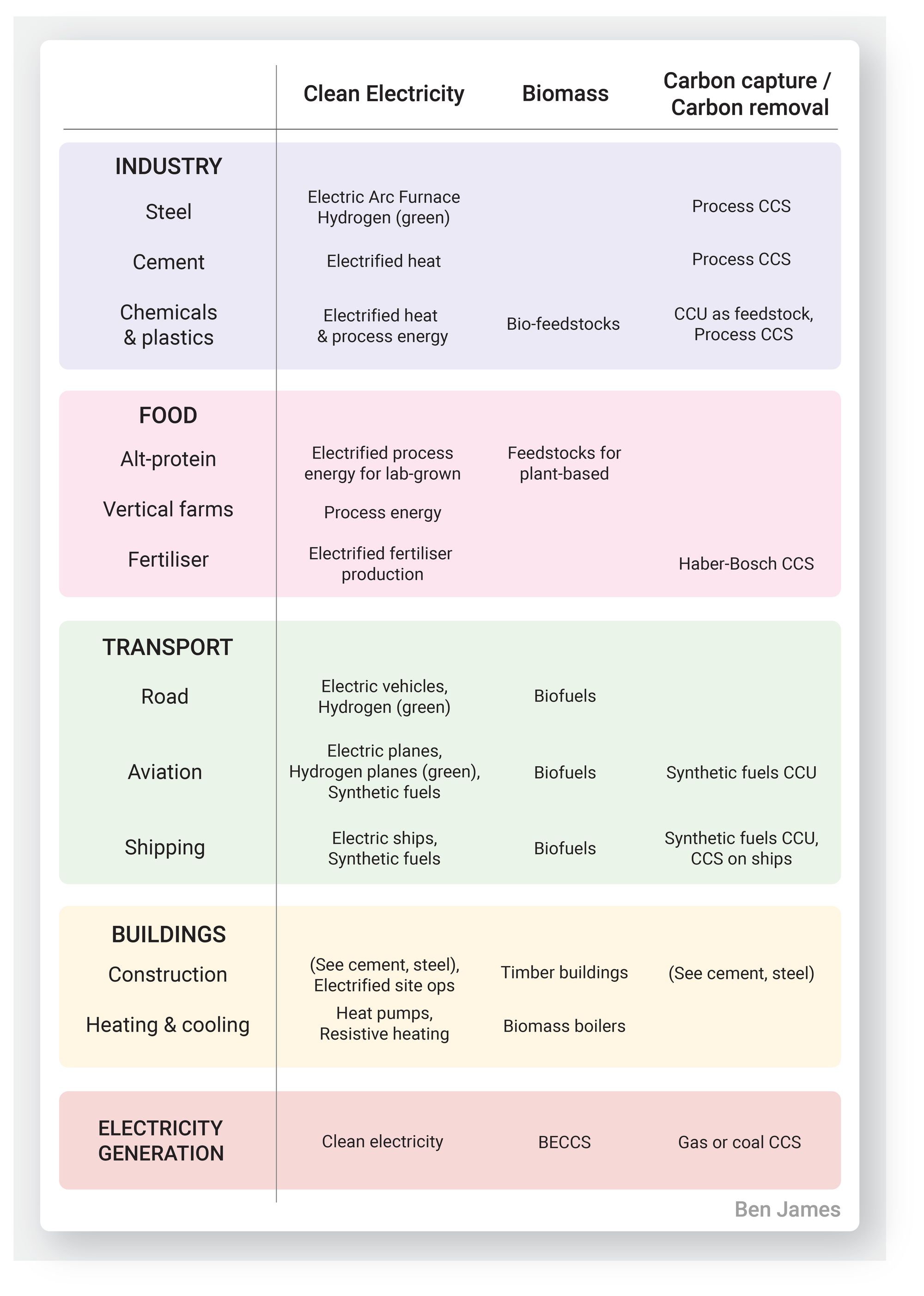
At this point, you may be trying to think of exceptions to the rule. What about smart thermostats, or tech that reduces food waste? These fall under the category of demand reduction. Tech in this category is usually awesome low-hanging fruit with great financial incentives.
But once we’ve done all the demand reduction that we can, we will need to decarbonise everything that’s left. For everything that we want to continue doing, we’ll need to use one of the three ingredients.
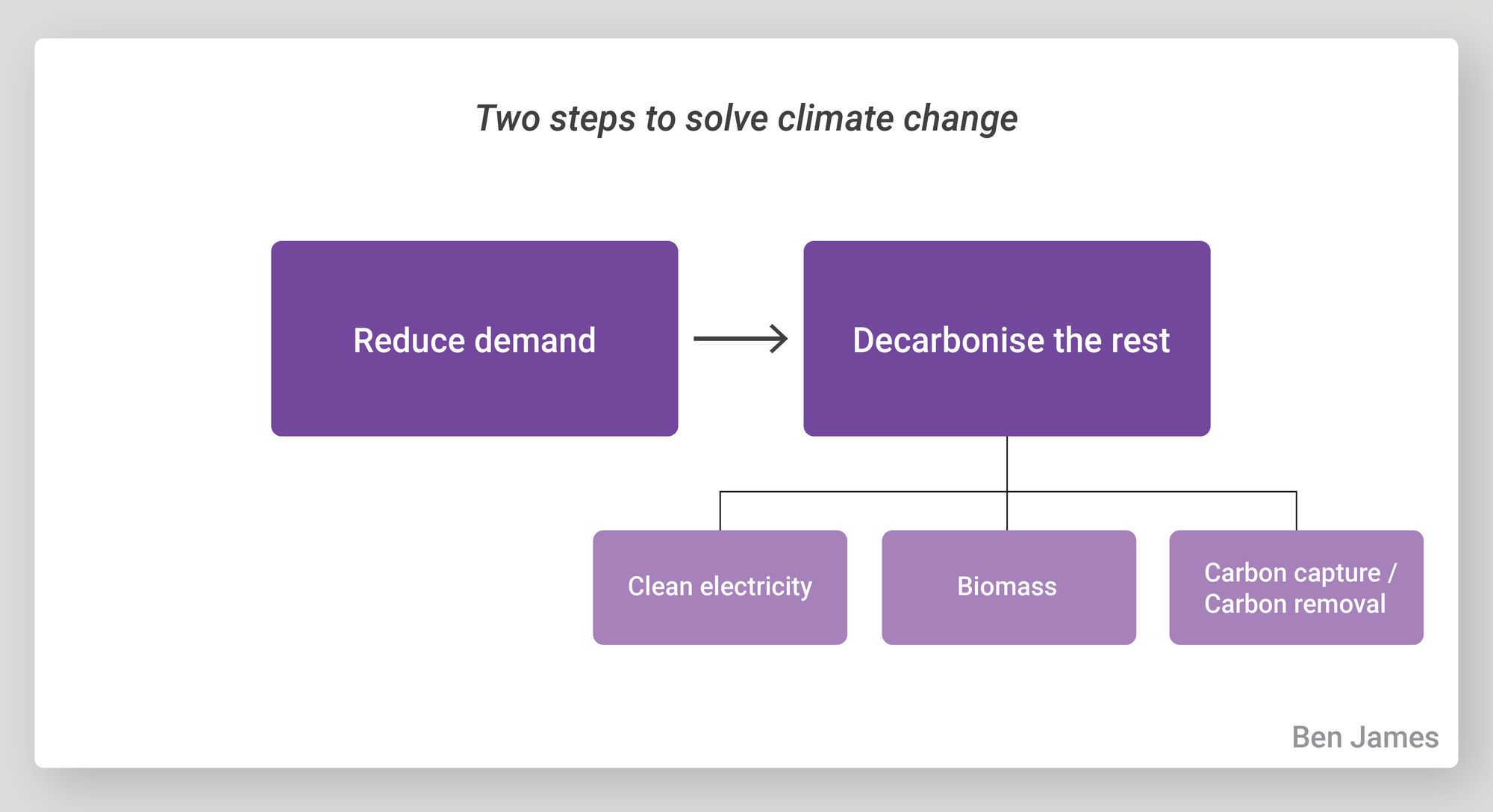
OK - so decarbonising our existing processes depends on these three resources. Why is that important?
It's important because all three of our critical ingredients are limited.
To illustrate this, I’ve plotted three future Net Zero scenarios modelled by different organisations. Since we're measuring the use of three resources, they're plotted in 3D. The points represents how much of each resource is used annually in the year 2050. Compared to today, most future Net Zero scenarios assume that we use a lot more of these inputs.
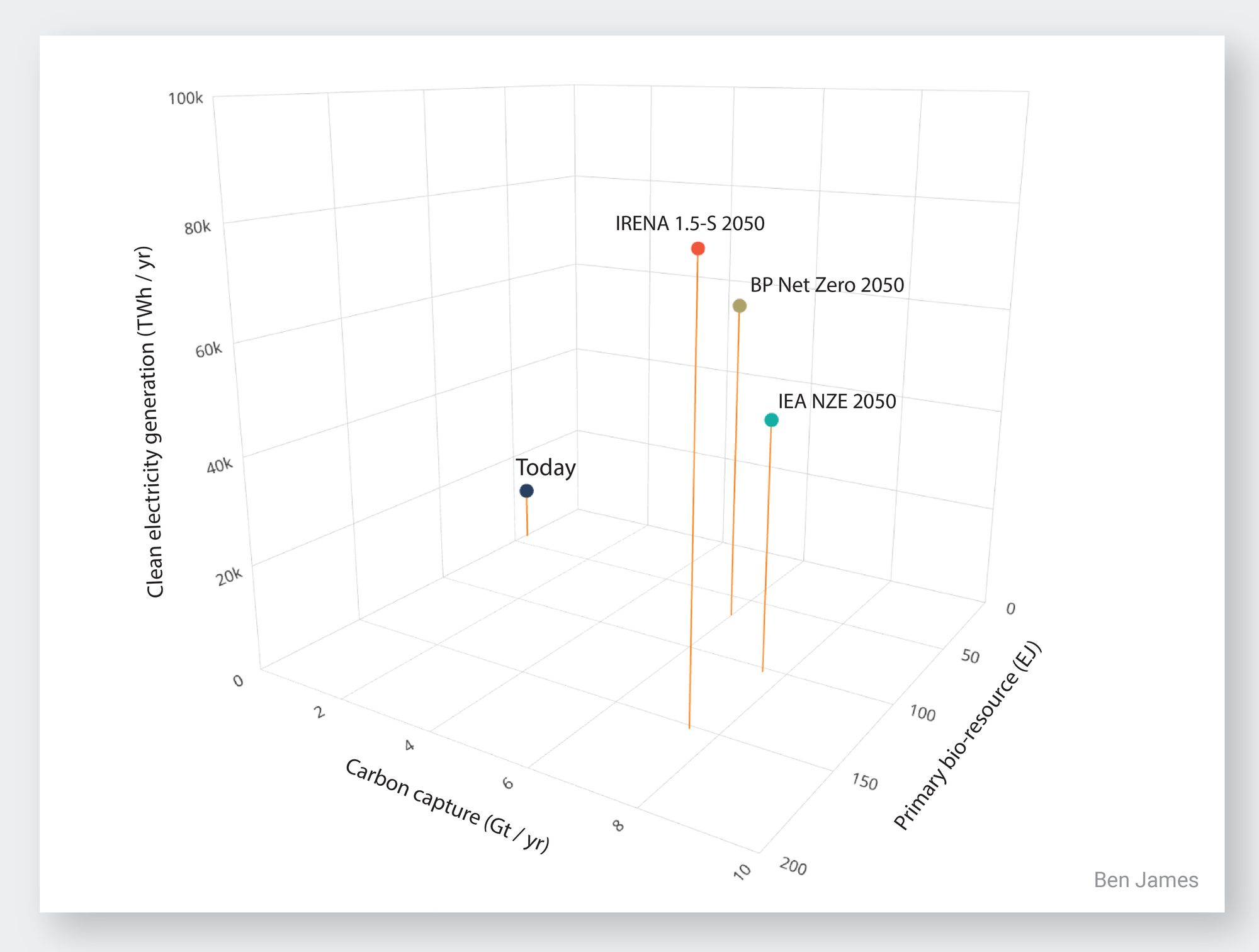
Note that today, our total carbon capture capacity is 0.043 Gigatons / year, which doesn’t even take us off the axis.
Allocation matters
To return to our cooking analogy, it's not just that we only have three ingredients to cook with, it's that we have a limited amount of them in the cupboard.
You could use all your eggs (bioenergy) to make an omlette (jet fuel), but then you wouldn’t have any left over as ingredients for other things (chemicals, steel, etc).
Therefore, we have to carefully choose how we allocate the resources we have.
Limitations to biomass
Most energy experts immediately wince when biomass is mentioned as a solution, simply because our supply of sustainable biomass is so constrained.
Food production is the leading cause of deforestation, so dedicated biomass production that competes with food supply should be meticulously avoided. There is a small amount of waste biomass that we can use, but it will be under intense demand from a variety of sectors. Using it to decarbonise the chemicals industry alone would highly stress our supplies.
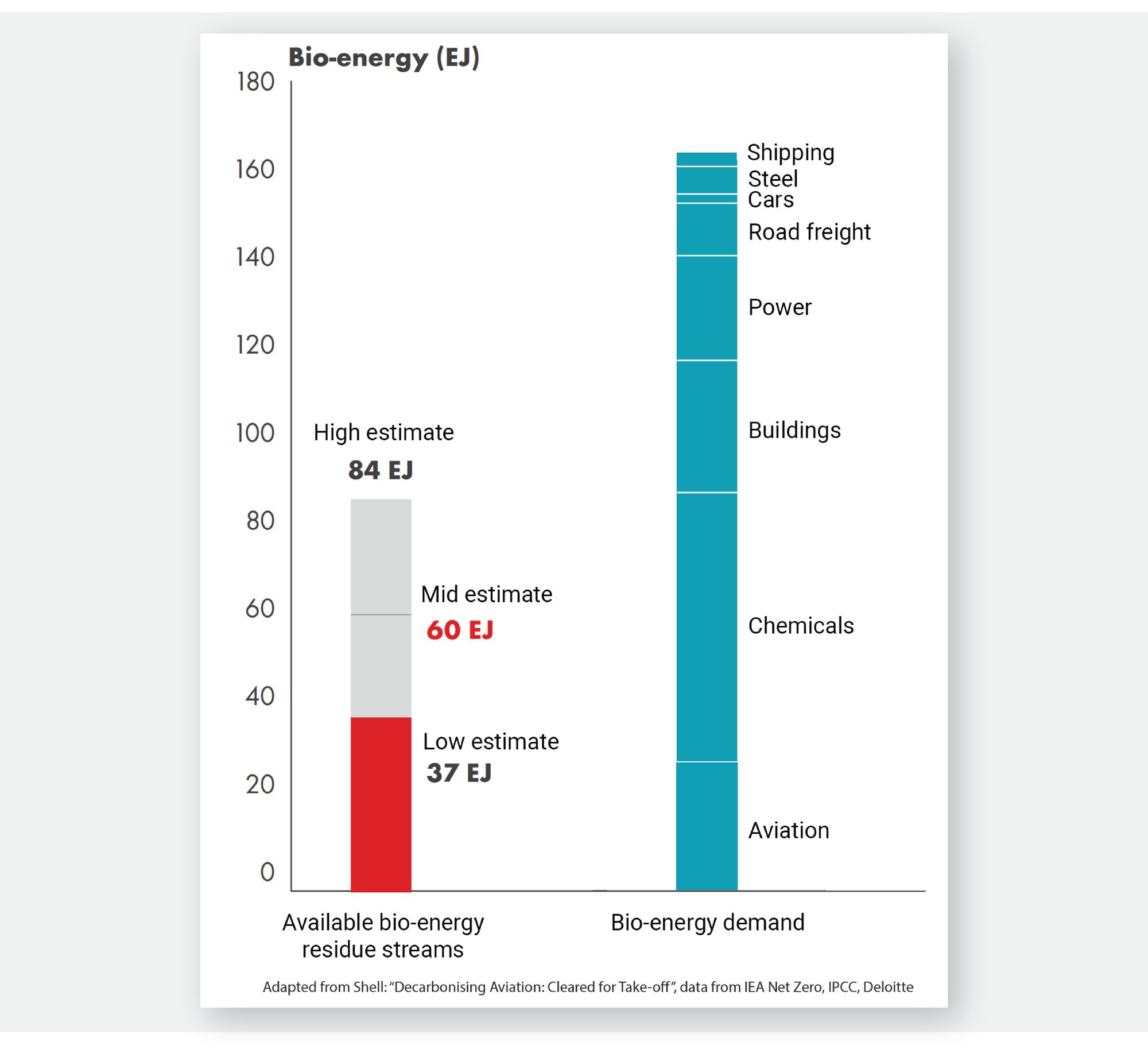
Limitations to carbon capture and carbon removal
Carbon capture and carbon removal are two separate and complex topics that are difficult to do justice to in one paragraph.
On the one hand, a certain amount of carbon capture and carbon removal will be essential to Net Zero, not least to provide the CO2 for sustainable chemicals, fuels, and plastics. Market commitments (both public and private) are setting the stage for tremendous growth in both.
On the other hand, the limitations of both carbon capture and carbon removal are infamous, and for good reason. Whilst plopping carbon capture on a cement plant conceptually sounds quite easy, in practise it is expensive and temperamental. Carbon capture has been a leading talking point since the very first COP in 1995, but has made very little progress since.
People love to talk about new announcements of CCS projects. But our actual global capacity is miniscule, and has barely grown in the last decade.
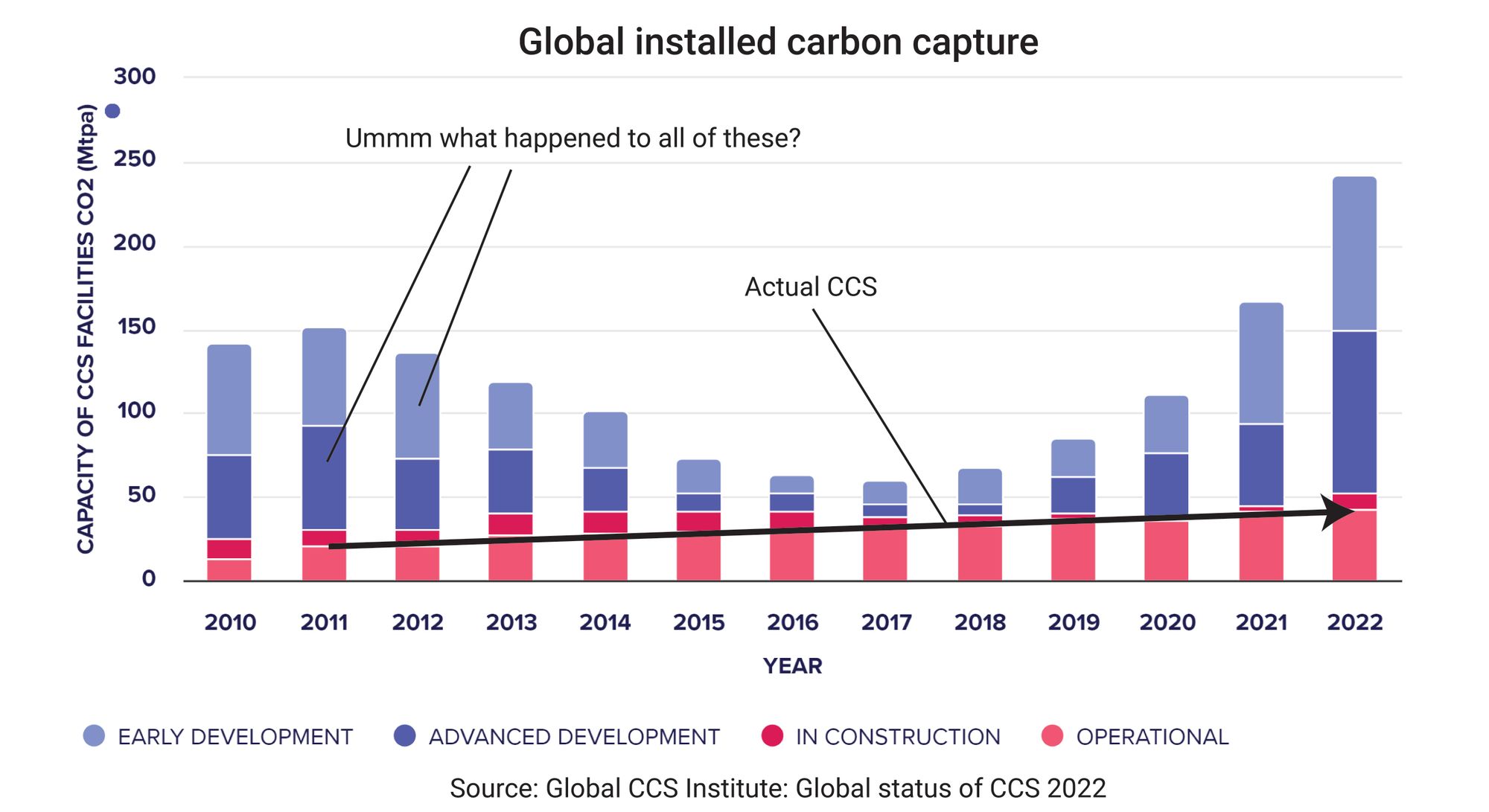
Regardless of your optimism on CCS and/or CDR, it's safe to assume that neither will contribute more than 5% of emissions reduction before 2040.
Limitations to clean electricity ..?
So, we are left with clean electricity.
Out of our three resources, clean electricity is the least limited one. It is also the only one currently undergoing exponential growth.
We will deploy solar, batteries and (to a lesser extent) wind, like nobody's business. In 2024, we are deploying a megawatt of solar per minute, and the plummeting cost of PV means that it will eat the world.
But energy infrastructure is deeply distributed in the real world. It is subject to planning, permitting, grid constraints, and everything that afflicts big projects.
PV and batteries will scale stupidly fast, but so will our demand. We will be moving towards abundant renewables by 2035, but they will not be unlimited in the short term.
Asking good questions
My favourite thing about the three-ingredient thinking lens is that you can use it to ask really good questions about decarbonisation tech.
If someone tells you that they’re making clean cement, clean jet fuel or clean plastics, you can ask them how much renewable electricity, biomass, or carbon capture they need. Usually, it’s quite a lot of one of the three.
It’s easy to get confused or distracted when someone explains their complex chemical or biological process for turning X into Y. But you can cut through a lot of complexity by asking questions like these:
If their solution depends on clean electricity (A):
- How many tonnes of CO2 do you save per kWh of clean electricity used?
- How does this compare to alternative uses for clean electricity? For example, displacing gas/coal generation?
If their solution depends on biomass (B):
- Where the heck are you getting your biomass from?
- Is it competing with food supply? Is it interrupting any natural carbon cycles?
- Is it competing with biomass supply for other climate solutions? If so, how many tonnes of CO2 can the other climate solutions save for the same amount of biomass?
If their solution uses carbon capture / carbon removal (C)
- For Direct Air Capture: how are you powering it? See questions from (A).
- For bio-based solutions: see questions from (B).
- For point-source capture & utilisation: how additional is this emissions reduction from utilisation? Isn't this emissions source going to be redundant or sequestered soon anyway?
- For point-source capture & sequestration: how reliable is your storage, what is your capture rate, & what is the uptime of your capture equipment?
Of course these questions are overly generalised, but they can be a good place to start.
In summary
The best climate tech does one of three things:
(1) Increases the abundance of one of these three resources
(2) Reduces consumption that would otherwise have needed to be decarbonised using one of these three resources
(3) Uses one of these three resources to decarbonise something really efficiently.
Conclusions
Let me know if you found this interesting, if you disagree, or if you just want to say hi 👋.
Lastly, if you enjoyed reading this, I'll be posting more soon. You can leave your email to get notified about new posts 💌.
Thanks to Prof. Julian Allwood for originally introducing me to this idea. And thanks to Archy de Berker for thoughtfully emphasising how important the tech is that increases the abundance of these three resources.
Sources are linked here.
Caveats
The broad exceptions to this rule are renewable sources of heat. Solar thermal for domestic use or industrial process heat is a sizable exception. So would be geothermal (heat only - not electricity).